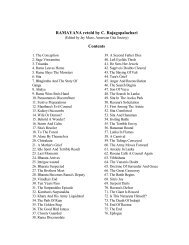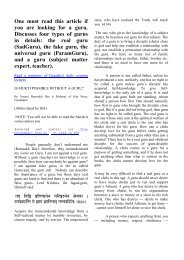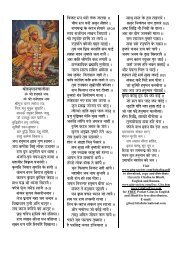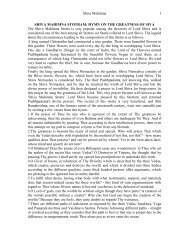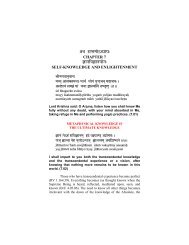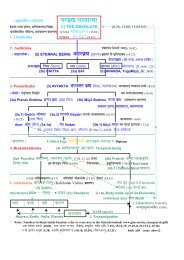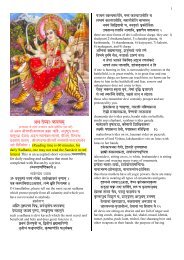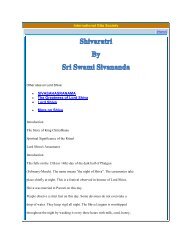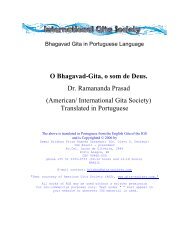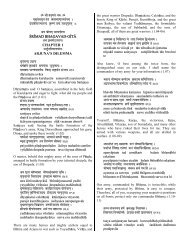- Page 1 and 2:
CONTENTS CANTO ONE Internatonal Git
- Page 3 and 4:
60 Chapter Ten Bhagavatam Is the An
- Page 5 and 6:
129 Chapter Thirty-three Activities
- Page 7 and 8:
CANTO FIVE Chapter One The Activiti
- Page 9 and 10:
Chapter Six The Progeny of the Daug
- Page 11 and 12:
365 Chapter Six The Demigods and De
- Page 13 and 14:
429 Chapter Fourteen King Pururava
- Page 15 and 16:
Chapter Twenty-Two Krsna Steals the
- Page 17 and 18:
559 Chapter Fifty-Seven Satrajit Mu
- Page 19 and 20:
Chapter Eighty-Nine Krsna and Arjun
- Page 21 and 22:
CANTO TWELVE Chapter One The Degrad
- Page 23 and 24:
11. There are many varieties of scr
- Page 25 and 26:
ealizes that Absolute Truth by rend
- Page 27 and 28:
2. A part of the purusa lies down w
- Page 29 and 30:
Prajapatis. 28. All of the above-me
- Page 31 and 32:
7. How did it so happen that King P
- Page 33 and 34:
identifying with the body or the mi
- Page 35 and 36:
living together during the four mon
- Page 37 and 38:
8. When I was a mere child of five
- Page 39 and 40:
due to desiring contact of the sens
- Page 41 and 42:
withdraw such weapons. 21. Thereupo
- Page 43 and 44:
oyal family and brings grief upon a
- Page 45 and 46:
maintains and annihilates all mater
- Page 47 and 48:
attraction be constantly drawn unto
- Page 49 and 50:
philosophers inquire exhaustively,
- Page 51 and 52:
Arjuna's chariot by all means. Thos
- Page 53 and 54:
vina, gomukha and bheri, all sounde
- Page 55 and 56:
sounded by Him, appeared to be redd
- Page 57 and 58:
dark cloud were surrounded simultan
- Page 59 and 60:
purificatory process of birth perfo
- Page 61 and 62:
3-4. When they saw Vidura return to
- Page 63 and 64:
y praying, offering fire sacrifice
- Page 65 and 66:
will turn to ashes. 58. While outsi
- Page 67 and 68:
elatives, such as Madhu, Bhoja, Das
- Page 69 and 70:
performance of Rajasuya-yajna and p
- Page 71 and 72:
Thus he was freed from the three mo
- Page 73 and 74:
demigods. 4. Once, when Maharaja Pa
- Page 75 and 76:
26-30. In Him reside (1) truthfulne
- Page 77 and 78:
decorations. 16. The supreme duty o
- Page 79 and 80:
leaders, brahmanas and sannyasis, s
- Page 81 and 82:
service unto the Lord, although He
- Page 83 and 84:
horse sacrifices. When such a king
- Page 85 and 86:
and they spoke as follows. 20. [The
- Page 87 and 88:
2. Those persons who are materially
- Page 89 and 90:
the depression of His navel. 28. Th
- Page 91 and 92:
earrings. 10. His lotus feet are pl
- Page 93 and 94:
in this point of neutralization and
- Page 95 and 96:
one who utilizes the time by discus
- Page 97 and 98:
Krsna. The highly intellectual, sim
- Page 99 and 100:
is I" and "It is mine." 14. The fiv
- Page 101 and 102:
eternal. 40-41. My dear son Narada,
- Page 103 and 104:
manifestations, like the sun, which
- Page 105 and 106:
the ear. These pastimes are pleasin
- Page 107 and 108:
can take one's rightful possession.
- Page 109 and 110:
and Rukmi, as also great warriors l
- Page 111 and 112:
potencies, are certainly auspicious
- Page 113 and 114:
26. O learned brahmana, because of
- Page 115 and 116:
abode. 18. Lord Brahma, thus seeing
- Page 117 and 118:
grandfather of all the universe, af
- Page 119 and 120:
of air, carrying smell, also became
- Page 121 and 122:
the idea that material nature is th
- Page 123 and 124:
18. He began to travel alone, think
- Page 125 and 126:
41. O gentle one, I simply lament f
- Page 127 and 128:
18. Who, after smelling the dust of
- Page 129 and 130:
killed by the Lord in a fight. His
- Page 131 and 132:
2. As by the friction of bamboos de
- Page 133 and 134:
instructed by the Personality of Go
- Page 135 and 136:
feet of Lord Krsna by the devotee w
- Page 137 and 138:
38. The controlling deities of all
- Page 139 and 140:
ests the aggregate creation, which
- Page 141 and 142:
34. All these different social divi
- Page 143 and 144:
20. Persons whose austerity is meag
- Page 145 and 146:
extreme miseries for the sake of ve
- Page 147 and 148:
systems, upper, middle and lower. H
- Page 149 and 150:
hearing, and thus their hearts beco
- Page 151 and 152:
of illusion. 33. When you are free
- Page 153 and 154:
in the same way in the future. 14.
- Page 155 and 156:
9. The measuring pot for one nadika
- Page 157 and 158:
times in the different planets. 34.
- Page 159 and 160:
fiery flames from their eyes, and t
- Page 161 and 162: codes, and the celebrated hymns bhu
- Page 163 and 164: 12. O King, if you can give proper
- Page 165 and 166: 37. Moreover, O Lord, the repetitio
- Page 167 and 168: 9. The sun was setting, and the sag
- Page 169 and 170: from his daily duties of offering e
- Page 171 and 172: were born from my mind, are your pr
- Page 173 and 174: Probably these two persons are impo
- Page 175 and 176: Chapter Sixteen The Two Doorkeepers
- Page 177 and 178: lessings, kindly drive away the ele
- Page 179 and 180: their mouths, and jackals and owls
- Page 181 and 182: The demon laughed: Oh, an amphibiou
- Page 183 and 184: Demon Hiranyaksa 1. Sri Maitreya sa
- Page 185 and 186: head scattered, he fell down dead,
- Page 187 and 188: this manifested universe? 11. Did t
- Page 189 and 190: 37. The asuras, clouded in their un
- Page 191 and 192: with slick dark locks of curly hair
- Page 193 and 194: sarovara, which was encircled by th
- Page 195 and 196: 7. I have fortunately been instruct
- Page 197 and 198: in a Krsna conscious atmosphere. 35
- Page 199 and 200: thinking them live birds like thems
- Page 201 and 202: 48. Immediately afterward, on the s
- Page 203 and 204: as an incarnation by His internal e
- Page 205 and 206: surface of the globe as a sannyasi,
- Page 207 and 208: 20. Every learned man knows very we
- Page 209 and 210: urns out of fear of Me, and death g
- Page 211: from distraction. 23-24. The materi
- Page 215 and 216: the sun remains aloof from its refl
- Page 217 and 218: consciousness. 28-29. My devotee ac
- Page 219 and 220: view of all His limbs, but should f
- Page 221 and 222: ody in a dream. 39. Because of grea
- Page 223 and 224: Supersoul everywhere and engages hi
- Page 225 and 226: death, Yamaraja. Chapter Thirty Des
- Page 227 and 228: cases he is made to eat his own fle
- Page 229 and 230: ecause He is always glorious in His
- Page 231 and 232: her grip. 39. One who aspires to re
- Page 233 and 234: the influence of the time factor. T
- Page 235 and 236: 40. It is not to be instructed to p
- Page 237 and 238: 18. The compound of the main househ
- Page 239 and 240: eternal consort of Lord Visnu. 5. S
- Page 241 and 242: and therefore as you have decided,
- Page 243 and 244: with mercy and then departed for Ga
- Page 245 and 246: went back to his home. 20. Upon und
- Page 247 and 248: flapping flags and the performance
- Page 249 and 250: 8. Although she was received by her
- Page 251 and 252: in such a manner? 29. It was astoni
- Page 253 and 254: Pusa. Nandisvara arrested the demig
- Page 255 and 256: plaksas, nyagrodhas and trees produ
- Page 257 and 258: expansion of your personality, exac
- Page 259 and 260: consciousness began to offer prayer
- Page 261 and 262: 31. Lord Brahma said: My dear Lord,
- Page 263 and 264:
followers of Lord Siva. 49. Maitrey
- Page 265 and 266:
11. Queen Suruci told Dhruva Mahara
- Page 267 and 268:
ealization. 32. For this reason, my
- Page 269 and 270:
perfect human beings flying in the
- Page 271 and 272:
without diversion to anything else,
- Page 273 and 274:
heart always hankers after Your lot
- Page 275 and 276:
Personality of Godhead, who can imm
- Page 277 and 278:
55. At each and every gate there we
- Page 279 and 280:
mountain is covered by incessant ra
- Page 281 and 282:
7. Lord Manu said: My dear son, ple
- Page 283 and 284:
thus, by self-realization, you will
- Page 285 and 286:
Supreme Lord. 16. Thus Dhruva Mahar
- Page 287 and 288:
37. Persons who are peaceful, equip
- Page 289 and 290:
equipoised, for he could see everyt
- Page 291 and 292:
34. The performer of the sacrifices
- Page 293 and 294:
dangerous position due to an irresp
- Page 295 and 296:
sinful person. If he lives, he will
- Page 297 and 298:
8. Conchshells, bugles, drums and k
- Page 299 and 300:
eceived from authoritative sages an
- Page 301 and 302:
demoniac rogues and thieves will hi
- Page 303 and 304:
protect yourself and your subjects
- Page 305 and 306:
simply unsuccessful again and again
- Page 307 and 308:
31. In this way the King founded ma
- Page 309 and 310:
22. Then the great hero, Vijitasva,
- Page 311 and 312:
Visnu, appeared on the scene. Accom
- Page 313 and 314:
way. He simply embraced the Lord wi
- Page 315 and 316:
1. The great sage Maitreya told Vid
- Page 317 and 318:
of all destiny. 24. Any king who do
- Page 319 and 320:
until the end of my life. He who ca
- Page 321 and 322:
13. Prthu Maharaja inquired from th
- Page 323 and 324:
stones. 34. Those who strongly desi
- Page 325 and 326:
55. Since Maharaja Prthu was a perf
- Page 327 and 328:
can never be dispelled. 13. In due
- Page 329 and 330:
of life, gain promotion to the heav
- Page 331 and 332:
absorbed in meditation to attain hi
- Page 333 and 334:
maintain the mind, senses, body, an
- Page 335 and 336:
universe is manifested, is You. 61.
- Page 337 and 338:
Siva instructed the sons of King Ba
- Page 339 and 340:
that is preceding you? 28. My dear
- Page 341 and 342:
used to visit the city named Daksin
- Page 343 and 344:
captivated by Cupid, and was moved
- Page 345 and 346:
8. After this, King Puranjana, King
- Page 347 and 348:
Puranjana's city and thus rendered
- Page 349 and 350:
next life he became a very beautifu
- Page 351 and 352:
54. My dear gentle friend, both you
- Page 353 and 354:
gates, situated in the west are kno
- Page 355 and 356:
providence, other living entities o
- Page 357 and 358:
United with his wife, he always rem
- Page 359 and 360:
influenced by the three modes of ma
- Page 361 and 362:
friendly with their brothers and wi
- Page 363 and 364:
only are all desires of the neophyt
- Page 365 and 366:
in the work of generating living en
- Page 367 and 368:
Godhead, Janardana. 20. Being compl
- Page 369 and 370:
supremely powerful Lord Brahma, acc
- Page 371 and 372:
names of Agni, the fire-god. 26. Th
- Page 373 and 374:
Agnidhra 1. Sri Sukadeva Gosvami co
- Page 375 and 376:
Brahma, being pleased with me, has
- Page 377 and 378:
here just so we can see You. You ha
- Page 379 and 380:
devotion. 5. King Nabhi understood
- Page 381 and 382:
Teachings to His Sons 1. Lord Rsabh
- Page 383 and 384:
suffering. Such a foolish person do
- Page 385 and 386:
wide like the petals of a newly gro
- Page 387 and 388:
11. Low-class people, due to their
- Page 389 and 390:
as the Supreme Absolute Truth, and
- Page 391 and 392:
interests, although they may be ver
- Page 393 and 394:
present life, he constantly repente
- Page 395 and 396:
insulted and neglected by materiali
- Page 397 and 398:
ecently engaged to work with us can
- Page 399 and 400:
saints such as Dattatreya and other
- Page 401 and 402:
of bodies among demigods, human bei
- Page 403 and 404:
5-6. The self-realized brahmana Jad
- Page 405 and 406:
wife and children enter the heart o
- Page 407 and 408:
death. 20. My dear King Rahugana, y
- Page 409 and 410:
and rats give him trouble. Nonethel
- Page 411 and 412:
23. Learned scholars and transcende
- Page 413 and 414:
full of danger. Sometimes the condi
- Page 415 and 416:
meant to protect the universe, are
- Page 417 and 418:
the principal regions, such as Bhu-
- Page 419 and 420:
sufficiently supplied for their pro
- Page 421 and 422:
10. Many other rivers, both big and
- Page 423 and 424:
1. Sri Sukadeva Gosvami said: Bhadr
- Page 425 and 426:
one for each day and each night in
- Page 427 and 428:
Except for a devotee in transcenden
- Page 429 and 430:
ealized souls, and He is their very
- Page 431 and 432:
everything else. That bhakti-yoga,
- Page 433 and 434:
heavenly planet. 5. [This is the ma
- Page 435 and 436:
three planetary systems, known as B
- Page 437 and 438:
affairs of the material world. To b
- Page 439 and 440:
in the celestial sphere and then se
- Page 441 and 442:
10. Because the moon is full of all
- Page 443 and 444:
8. My dear King, the body of the si
- Page 445 and 446:
eginning from Atala. In Atala there
- Page 447 and 448:
28. Beneath the planet known as Sut
- Page 449 and 450:
all transcendental. The Supreme Lor
- Page 451 and 452:
for his envy of other creatures by
- Page 453 and 454:
wife to drink his semen out of a lu
- Page 455 and 456:
CANTO SIX Chapter One The History o
- Page 457 and 458:
method of atonement. Even in dreams
- Page 459 and 460:
contamination of the three modes of
- Page 461 and 462:
of his sinful acts, he will be puni
- Page 463 and 464:
20. Sri Sukadeva Gosvami continued:
- Page 465 and 466:
of the goddess of fortune. 45. Ajam
- Page 467 and 468:
of the Supreme Personality of Godhe
- Page 469 and 470:
vows and performing Vedic ritualist
- Page 471 and 472:
eings, birds, beasts, aquatics and
- Page 473 and 474:
Personality of Godhead please fulfi
- Page 475 and 476:
4-5. In that holy place, the Haryas
- Page 477 and 478:
22. The seven musical notes--sa, r,
- Page 479 and 480:
inauspicious thing. Therefore you a
- Page 481 and 482:
28. The sons born of Krodhavasa wer
- Page 483 and 484:
would sink in the water with its pa
- Page 485 and 486:
ahmana who desires to achieve happi
- Page 487 and 488:
unlimited hellish planets. 18. May
- Page 489 and 490:
38. O King of heaven, a brahmana na
- Page 491 and 492:
Brahma. Being very much afraid that
- Page 493 and 494:
with proper intelligence who knows
- Page 495 and 496:
spiritual science and then delivere
- Page 497 and 498:
Vrsaparva, Praheti, Heti and Utkala
- Page 499 and 500:
Airavata, feeling great pain and sp
- Page 501 and 502:
Supreme Personality of Godhead when
- Page 503 and 504:
oth of them were great fighters and
- Page 505 and 506:
Wait!" 14. O King, Indra first fled
- Page 507 and 508:
was full of anxiety because he did
- Page 509 and 510:
fevers, with a desire to have sons.
- Page 511 and 512:
lamentation, he went there with Nar
- Page 513 and 514:
combination of the physical element
- Page 515 and 516:
they gave it up very easily. 14. Qu
- Page 517 and 518:
You are certainly conquered by devo
- Page 519 and 520:
I am the Supersoul of all living be
- Page 521 and 522:
6. Citraketu said: Lord Siva, the s
- Page 523 and 524:
28. Devotees solely engaged in the
- Page 525 and 526:
they proceeded from the womb of Dit
- Page 527 and 528:
lamented, "now I face the danger of
- Page 529 and 530:
her embryo, which appeared like glo
- Page 531 and 532:
worshiping You." One should chant t
- Page 533 and 534:
CANTO SEVEN Chapter One The Supreme
- Page 535 and 536:
persons, to enter very easily into
- Page 537 and 538:
tortured him in many ways. 43. The
- Page 539 and 540:
his nephews, whose names were Sakun
- Page 541 and 542:
and others sometimes dies, no one b
- Page 543 and 544:
in understanding the real philosoph
- Page 545 and 546:
and began to express his obligation
- Page 547 and 548:
universe resided there. 9-12. The s
- Page 549 and 550:
33. Although Prahlada Maharaja was
- Page 551 and 552:
in devotional service, thus being f
- Page 553 and 554:
28. The son of Sukracarya, Hiranyak
- Page 555 and 556:
has assimilated our instructions or
- Page 557 and 558:
silkworm, which weaves a cocoon in
- Page 559 and 560:
severe attempt to subdue all the de
- Page 561 and 562:
26. As one can understand the prese
- Page 563 and 564:
What more can be said about this? 4
- Page 565 and 566:
10. In former times there were many
- Page 567 and 568:
These soldiers had come in thousand
- Page 569 and 570:
universe. 50. The inhabitants of Ga
- Page 571 and 572:
12. Therefore, although I was born
- Page 573 and 574:
etween the lower and the higher. 28
- Page 575 and 576:
their families, societies and count
- Page 577 and 578:
desire to maintain a prestigious po
- Page 579 and 580:
enedictions to any demon again. 31.
- Page 581 and 582:
vanquish the three worlds--the uppe
- Page 583 and 584:
tolerance, discrimination between r
- Page 585 and 586:
gives up these activities, he attai
- Page 587 and 588:
only to keep the sacred fire, but h
- Page 589 and 590:
10. Although a saintly person may n
- Page 591 and 592:
invariably afraid. 34. Those in hum
- Page 593 and 594:
11. Dogs, fallen persons and untouc
- Page 595 and 596:
Personality of Godhead, Krsna, in w
- Page 597 and 598:
eal religious life must abandon the
- Page 599 and 600:
free from disturbance, like a fire
- Page 601 and 602:
sun, the day, the end of the day, t
- Page 603 and 604:
77. Present here now is the same Su
- Page 605 and 606:
eligion. I request everyone to foll
- Page 607 and 608:
athe in it, their bodies lend fragr
- Page 609 and 610:
every living being. Let me meditate
- Page 611 and 612:
ask the Lord for any benediction. I
- Page 613 and 614:
Indradyumna Maharaja. 8. Indradyumn
- Page 615 and 616:
8. During the reign of Caksusa Manu
- Page 617 and 618:
have achieved freedom from agitatio
- Page 619 and 620:
automatically pleased. Similarly, w
- Page 621 and 622:
drugs. Then, with My help, making M
- Page 623 and 624:
powerful Lord, whose determination
- Page 625 and 626:
known as Paramatma. 30. O lord, you
- Page 627 and 628:
They were headed by Airavana. Eight
- Page 629 and 630:
goddess of fortune, by her favorabl
- Page 631 and 632:
position, we therefore request You
- Page 633 and 634:
and life by one's words, one's mind
- Page 635 and 636:
Durgadevi, who is called Bhadra Kal
- Page 637 and 638:
Supreme Lord, who severed their hea
- Page 639 and 640:
on the battlefield, were very anxio
- Page 641 and 642:
as follows. 4. Lord Mahadeva said:
- Page 643 and 644:
elt that covered her. 24. Thus Lord
- Page 645 and 646:
Prsadhra, and the tenth son is know
- Page 647 and 648:
33. The name of the fourteenth Manu
- Page 649 and 650:
sword and a quiver of arrows. When
- Page 651 and 652:
very satisfied, became very opulent
- Page 653 and 654:
instructed me, by which Kesava, the
- Page 655 and 656:
should be a pure and simple devotee
- Page 657 and 658:
long as that of Lord Brahma, a body
- Page 659 and 660:
and oceans, and in the core of ever
- Page 661 and 662:
30. O my Lord, because You have kin
- Page 663 and 664:
words, but You are asking only thre
- Page 665 and 666:
earning one's livelihood, when one'
- Page 667 and 668:
the Supreme Personality of Godhead'
- Page 669 and 670:
taken them away on the plea of begg
- Page 671 and 672:
follows. 2. Bali Maharaja said: O b
- Page 673 and 674:
then can he deserve to suffer from
- Page 675 and 676:
with your grandson and your other r
- Page 677 and 678:
lord, what was the purpose of this
- Page 679 and 680:
have therefore manifested Your form
- Page 681 and 682:
water of inundation, explained to h
- Page 683 and 684:
18. You are all self-controlled, we
- Page 685 and 686:
4. Once at night, while it was rain
- Page 687 and 688:
the giver of money. 33. Trnabindu h
- Page 689 and 690:
22. Sukanya, however, being very pr
- Page 691 and 692:
great respect, I bow my head before
- Page 693 and 694:
with gold plate and whose hooves we
- Page 695 and 696:
is intolerable even to us. Go to Lo
- Page 697 and 698:
kindly favor this poor brahmana. Th
- Page 699 and 700:
nostrils. King Iksvaku had one hund
- Page 701 and 702:
came forth from the lower right sid
- Page 703 and 704:
as the flames of a fire cease when
- Page 705 and 706:
truthful, forbearing and concerned
- Page 707 and 708:
Therefore, how can we know You, who
- Page 709 and 710:
said of those who use the water of
- Page 711 and 712:
Therefore Vasistha struck her abdom
- Page 713 and 714:
Ramacandra left behind His kingdom,
- Page 715 and 716:
appealing to everyone. 26. O my lor
- Page 717 and 718:
as their father. 51. Lord Ramacandr
- Page 719 and 720:
19. After completing the sacrifice,
- Page 721 and 722:
as Kalapa-grama. At the end of Kali
- Page 723 and 724:
15. From Devarata came a son named
- Page 725 and 726:
whom the child actually belonged. S
- Page 727 and 728:
Indeed, they seek newer and newer f
- Page 729 and 730:
14. Learned scholars accept this Pa
- Page 731 and 732:
supposed to be the embodiment of al
- Page 733 and 734:
as a gift, the south to the brahma,
- Page 735 and 736:
Gambhira, and from Gambhira came a
- Page 737 and 738:
Being very kind to her, he caught h
- Page 739 and 740:
pleased to accept the old age of hi
- Page 741 and 742:
Personality of Godhead. Free from t
- Page 743 and 744:
16. When Sakuntala responded to Mah
- Page 745 and 746:
Chapter Twenty-one The Dynasty of B
- Page 747 and 748:
Udaksena, Bhallata. All these sons
- Page 749 and 750:
18-19. After the dynasty of the moo
- Page 751 and 752:
Dyumatsena; from Dyumatsena, Sumati
- Page 753 and 754:
Parasurama. Their names were Jayadh
- Page 755 and 756:
known as belonging to the dynasty o
- Page 757 and 758:
were chief personalities in the dyn
- Page 759 and 760:
is conveyed from spiritual master t
- Page 761 and 762:
Mathura. There he enjoyed the place
- Page 763 and 764:
leaves aside another, there is no o
- Page 765 and 766:
Without difficulty, transfer Him in
- Page 767 and 768:
28. The efficient cause of this mat
- Page 769 and 770:
kettledrums simultaneously vibrated
- Page 771 and 772:
powerful time, which is divided int
- Page 773 and 774:
an expansion of Yogamaya, and then
- Page 775 and 776:
hearted person as me, since both of
- Page 777 and 778:
Maharaja and Vasudeva 1-2. Sukadeva
- Page 779 and 780:
if I have taken birth again. Even t
- Page 781 and 782:
Vrtrasura had fallen when killed by
- Page 783 and 784:
41. Upon smelling the fragrance of
- Page 785 and 786:
fully equipped with mystic powers.
- Page 787 and 788:
devotee, you are full in everything
- Page 789 and 790:
anxiety, and their household engage
- Page 791 and 792:
Yasoda considered that Supreme Pers
- Page 793 and 794:
influence of the element of time, f
- Page 795 and 796:
12. This body, after all, is produc
- Page 797 and 798:
are not made of material elements,
- Page 799 and 800:
12. Once, after the uprooting of th
- Page 801 and 802:
37. In this way, Krsna and Balarama
- Page 803 and 804:
picnic in the forest. Having risen
- Page 805 and 806:
immediately be killed like Bakasura
- Page 807 and 808:
inquired from Sukadeva Gosvami in t
- Page 809 and 810:
20. Now expanding Himself so as to
- Page 811 and 812:
calves, who were His expansions. 41
- Page 813 and 814:
very humbly began, with faltering w
- Page 815 and 816:
material world, manifesting Yoursel
- Page 817 and 818:
universe unto You. 40. My dear Sri
- Page 819 and 820:
1. Sukadeva Gosvami said: When Lord
- Page 821 and 822:
can smell the fragrance of the tala
- Page 823 and 824:
fact had died, simply by the mercif
- Page 825 and 826:
upon His face, these gopis each too
- Page 827 and 828:
41. Obeisances unto You, who are ti
- Page 829 and 830:
Supreme Personality of Godhead, who
- Page 831 and 832:
fear. 25. Seeing His devotees so di
- Page 833 and 834:
Balarama far beyond the spot where
- Page 835 and 836:
Autumn in Vrndavana 1. Sukadeva Gos
- Page 837 and 838:
25. When the Vrndavana forest had t
- Page 839 and 840:
Chapter Twenty-One The Gopis Glorif
- Page 841 and 842:
Godhead as He wandered about in the
- Page 843 and 844:
25. [Lord Krsna said:] O saintly gi
- Page 845 and 846:
universe, simply laughed. Then He a
- Page 847 and 848:
―We have sinned, for we have deni
- Page 849 and 850:
Thus Lord Indra is the agent respon
- Page 851 and 852:
who neglect him. Therefore let us p
- Page 853 and 854:
25. Seeing that the fierce wind and
- Page 855 and 856:
qualities and activities. These are
- Page 857 and 858:
the rod of punishment in My hand. I
- Page 859 and 860:
Hari revealed to the cowherd men Hi
- Page 861 and 862:
living entities possess natural aff
- Page 863 and 864:
scratching them with His fingernail
- Page 865 and 866:
23. One gopi tied up her slender co
- Page 867 and 868:
protect the universe, You have now
- Page 869 and 870:
9. All the gopis enjoyed the greate
- Page 871 and 872:
ut in a special metrical pattern, a
- Page 873 and 874:
satisfied by serving the dust of Hi
- Page 875 and 876:
flowers. 23. Krsna and Balarama san
- Page 877 and 878:
the music attracts the black deer
- Page 879 and 880:
and also for his elephant-keepers.
- Page 881 and 882:
accepted the demigods’ worship in
- Page 883 and 884:
4. Since I am a materialistic perso
- Page 885 and 886:
26. Increasingly agitated by ecstas
- Page 887 and 888:
constable make the following announ
- Page 889 and 890:
eloved. 38. My dear King, the Supre
- Page 891 and 892:
11. Goodness, passion and ignorance
- Page 893 and 894:
their eyes from Them. 8. Nanda Maha
- Page 895 and 896:
arrogant servant of the King became
- Page 897 and 898:
follows. 10. [Trivakra said:] Come,
- Page 899 and 900:
Elephant Kuvalayapida 1. Sukadeva G
- Page 901 and 902:
and attain wealth, glory and power.
- Page 903 and 904:
the road, His smiling face merciful
- Page 905 and 906:
committed against innocent creature
- Page 907 and 908:
espectfully honored them with gifts
- Page 909 and 910:
the hand of His fully devoted, dear
- Page 911 and 912:
humanlike form. What pious deeds co
- Page 913 and 914:
12. The gopi said: O honeybee, O fr
- Page 915 and 916:
her. 36. Because your minds are tot
- Page 917 and 918:
eautiful according to material esti
- Page 919 and 920:
and with his head bowed in humility
- Page 921 and 922:
not tolerate the great qualities of
- Page 923 and 924:
queens, Asti and Prapti, went to th
- Page 925 and 926:
31. With the divine noose of Varuna
- Page 927 and 928:
He possesses the characteristics Na
- Page 929 and 930:
limitless, and thus even I cannot c
- Page 931 and 932:
63. O King, in your very next life
- Page 933 and 934:
questioned him as follows. 30. [The
- Page 935 and 936:
most excellent jeweled ornaments. 1
- Page 937 and 938:
then sipped water for purification.
- Page 939 and 940:
is auspicious for us, we shall conq
- Page 941 and 942:
esembles the sun, which neither com
- Page 943 and 944:
master. 14. Now kill this dreadful
- Page 945 and 946:
2. Maharaja Pariksit inquired: O br
- Page 947 and 948:
31. [Lord Krsna said:] It is for th
- Page 949 and 950:
15. ―It is the Supreme Lord who c
- Page 951 and 952:
Princesses 1. Sukadeva Gosvami said
- Page 953 and 954:
time came for their sister [Mitravi
- Page 955 and 956:
Chapter Fifty-Nine The Killing of t
- Page 957 and 958:
original seed. Obeisances unto You,
- Page 959 and 960:
9. As He contemplated her, the godd
- Page 961 and 962:
activities are transcendental, O al
- Page 963 and 964:
human society. 59. The almighty Lor
- Page 965 and 966:
should defeat Balarama at dice. He
- Page 967 and 968:
yellow garments and mighty arms. He
- Page 969 and 970:
Pretas, Matas, Pisacas, Kusmandas a
- Page 971 and 972:
transformations You sanction so tha
- Page 973 and 974:
heavens, or drops in a rain shower.
- Page 975 and 976:
40. I do not desire brahmanas‘ we
- Page 977 and 978:
Balarama, and He began dragging the
- Page 979 and 980:
19. Lord Krsna then addressed Paund
- Page 981 and 982:
Lord Hari. 5. Another time he enter
- Page 983 and 984:
darling of the Yadu dynasty did not
- Page 985 and 986:
carefully carry that dust on our he
- Page 987 and 988:
proper for Him to behave in this wa
- Page 989 and 990:
household affairs. 42. Having repea
- Page 991 and 992:
efore. The doorkeepers announced hi
- Page 993 and 994:
know perfectly the relative value o
- Page 995 and 996:
Lord Krsna. 24. As songs and musica
- Page 997 and 998:
4. Purified persons who constantly
- Page 999 and 1000:
for me, he should not be the conten
- Page 1001 and 1002:
enticement for the ears. 15. Please
- Page 1003 and 1004:
all expert authorities on the Vedas
- Page 1005 and 1006:
observed. There, just like thieves,
- Page 1007 and 1008:
ained down flowers. 14. Men and wom
- Page 1009 and 1010:
dissatisfied on the occasion of the
- Page 1011 and 1012:
simply fled the battle? What can I
- Page 1013 and 1014:
in this world. I shall now kill him
- Page 1015 and 1016:
suffers defeat. 17. Lord Balarama t
- Page 1017 and 1018:
6. Balvala cried out in agony and f
- Page 1019 and 1020:
y the Supreme Personality of Godhea
- Page 1021 and 1022:
school? When a twice-born student h
- Page 1023 and 1024:
14. Although he had apparently rece
- Page 1025 and 1026:
Meet the Inhabitants of Vrndavana 1
- Page 1027 and 1028:
31. Sukadeva Gosvami said: When Nan
- Page 1029 and 1030:
Govinda that are sung throughout th
- Page 1031 and 1032:
Godhead, O Draupadi. Burning with l
- Page 1033 and 1034:
Lord Krsna, the learned brahmanas r
- Page 1035 and 1036:
40. But you, O magnanimous soul, ar
- Page 1037 and 1038:
more months, honored by all the Yad
- Page 1039 and 1040:
this mortal body and think of You,
- Page 1041 and 1042:
ordinary Vedic rites. 47. The Supre
- Page 1043 and 1044:
came his way. 15. By the will of Pr
- Page 1045 and 1046:
holy places. 43. When his guests we
- Page 1047 and 1048:
of Kalapa. After bowing down to the
- Page 1049 and 1050:
and matter, or that material transa
- Page 1051 and 1052:
40. When a person realizes You, he
- Page 1053 and 1054:
offend even the demigods who have b
- Page 1055 and 1056:
will be freed from all enemies and
- Page 1057 and 1058:
nor the unequalled warrior Aniruddh
- Page 1059 and 1060:
60-61. Thus instructed by the Supre
- Page 1061 and 1062:
matter of great importance. Or do y
- Page 1063 and 1064:
inauspicious for all living entitie
- Page 1065 and 1066:
happened. 20. O King Pariksit, when
- Page 1067 and 1068:
spread knowledge of the Absolute Tr
- Page 1069 and 1070:
opinion. 41. A devotee should not s
- Page 1071 and 1072:
Personality of Godhead, my thirst i
- Page 1073 and 1074:
e merciful to those in an inferior
- Page 1075 and 1076:
orn from eggs, others from embryos,
- Page 1077 and 1078:
3. When the primeval Lord Narayana
- Page 1079 and 1080:
Lord also appeared as Vamana and to
- Page 1081 and 1082:
Godhead, Hari, who resides in the h
- Page 1083 and 1084:
the supreme peace and free oneself
- Page 1085 and 1086:
activities. Our Lord, those pure so
- Page 1087 and 1088:
the whole world. Therefore I have s
- Page 1089 and 1090:
this city of Dvaraka. 4. O saintly
- Page 1091 and 1092:
within this world. Kindly tell me,
- Page 1093 and 1094:
constantly, like the powerful curre
- Page 1095 and 1096:
only to trip and fall down. Chapter
- Page 1097 and 1098:
the sense of taste. 21. Although on
- Page 1099 and 1100:
gratification. In that condition th
- Page 1101 and 1102:
composed of the three modes of mate
- Page 1103 and 1104:
injunctions forbidding sinful activ
- Page 1105 and 1106:
26. Until his pious results are use
- Page 1107 and 1108:
activities it is only the senses, b
- Page 1109 and 1110:
age and death. He is free from all
- Page 1111 and 1112:
thickets, and snakes such as Kaliya
- Page 1113 and 1114:
passion and ignorance. When passion
- Page 1115 and 1116:
25. My dear sons, the mind has a na
- Page 1117 and 1118:
the Yoga System to Sri Uddhava 1. S
- Page 1119 and 1120:
a devotee thus fixed in loving serv
- Page 1121 and 1122:
one acquires whatever one desires,
- Page 1123 and 1124:
29. Just as the bodies of aquatics
- Page 1125 and 1126:
suppress and punish, and among serp
- Page 1127 and 1128:
through loving devotional intellige
- Page 1129 and 1130:
his breath by pranayama and chant t
- Page 1131 and 1132:
sudra, snd a sudra who cannot find
- Page 1133 and 1134:
the mind completely detached, one s
- Page 1135 and 1136:
36. Just as I, the Supreme Lord, ex
- Page 1137 and 1138:
Your Lordship. 9. My dear Lord, for
- Page 1139 and 1140:
is seeing the Supreme Personality o
- Page 1141 and 1142:
17. The human body, which can award
- Page 1143 and 1144:
object within its particular catego
- Page 1145 and 1146:
Vedic rituals cannot understand tha
- Page 1147 and 1148:
logical explanation can always be g
- Page 1149 and 1150:
element false ego in three phases
- Page 1151 and 1152:
See how illusion based on material
- Page 1153 and 1154:
heaven and liberation, would willin
- Page 1155 and 1156:
parties indifferent to them. 49. Pe
- Page 1157 and 1158:
ignorance. 8. From false ego in the
- Page 1159 and 1160:
even in gain, false pride, praying
- Page 1161 and 1162:
27. Faith directed toward spiritual
- Page 1163 and 1164:
15. Who but the Supreme Personality
- Page 1165 and 1166:
emanated from Your lotus mouth. The
- Page 1167 and 1168:
Mahabala and Bala, and Kumuda and K
- Page 1169 and 1170:
55. Not only the performer of the t
- Page 1171 and 1172:
and the elements of physical nature
- Page 1173 and 1174:
Chapter Twenty-Nine Bhakti-yoga 1.
- Page 1175 and 1176:
eternal, confidential goal of the V
- Page 1177 and 1178:
Yadu Dynasty 1. King Pariksit said:
- Page 1179 and 1180:
27. Lord Krsna, the son of Devaki,
- Page 1181 and 1182:
entered into His own abode. 7. As s
- Page 1183 and 1184:
3. The son of Rajaka will be Nandiv
- Page 1185 and 1186:
They will be erratic in their moods
- Page 1187 and 1188:
are situated in the naksatra called
- Page 1189 and 1190:
and opulence to these narrations bu
- Page 1191 and 1192:
drought. They will lack adequate cl
- Page 1193 and 1194:
thunder, and will pour down floods
- Page 1195 and 1196:
changes of position of the planets
- Page 1197 and 1198:
conditioned souls, tormented as we
- Page 1199 and 1200:
doubt. Created material products, t
- Page 1201 and 1202:
from Sakalya into three parts, he a
- Page 1203 and 1204:
also studied this edition of the At
- Page 1205 and 1206:
6. Suta Gosvami said: O great sage
- Page 1207 and 1208:
offered Them obeisances by falling
- Page 1209 and 1210:
You have personally appeared before
- Page 1211 and 1212:
achievements of an incompetent pers
- Page 1213 and 1214:
long time in the water of dissoluti
- Page 1215 and 1216:
three sounds. In the form of His tw
- Page 1217 and 1218:
38. Vivasvan as the sun-god, Ugrase
- Page 1219 and 1220:
Pracinabarhi, the discussion betwee
- Page 1221 and 1222:
and His form as the sun, the soul o
- Page 1223 and 1224:
living in a secluded place, giving



